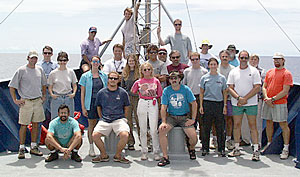|
|
TODAY'S WEATHER
Click here to see a movie of a hydrothermal vent.
Farewell from Expedition #3! As RV Melville cuts through the low, broad Pacific swells at 12.5 knots on a northwest course towards Manzanillo, Mexico, the scientific and technical teams on board have nearly finished packing. In fact, the computer I am using to write this last daily journal will be boxed up and put in the shipping vans tomorrow morning. Everyone on board is starting to relax after 6 weeks of nonstop activity. There is a lot of excitement and anticipation of arriving in Manzanillo on Wednesday and, for the science team and some of the crew, heading home before week’s end. What have we accomplished during this cruise? It has been spectacularly successful! We have mapped in detail and sampled three previously unexplored areas of the mid-ocean ridge crest where the Autonomous Hydrophone Array (AHA) had detected seismic events over the past few years. When we get back to our home institutions, we will begin many months, even years, of analyses and interpretation of the sonar and photographic data, and the rock samples. We will relate our sonar images of the seafloor to the bathymetric maps to learn about the sizes and shapes of volcanoes on the mid-ocean ridges. We will identify new lava flows from all the images that we have collected to determine which volcanoes erupted recently. We will test whether those recent eruptions are related to the seismic events detected with the hydrophones by determining the ages of the freshest lavas we have collected. Will the age of the rocks match the timing of the earthquake activity? Only time (and a lot of painstaking scientific work) will tell! Mike Perfit and his students will analyze the volcanic glass samples that we have collected to determine their chemical compositions. From those data, they will be able to reconstruct the history of the lavas -- how deep in the Earth they came from, whether they pooled in a magma chamber before erupting on to the seafloor, and how each lava flow is related to the others. Just like a jigsaw puzzle, this information will be fitted together with all the other data to learn about how the ocean floor is built along the mid-ocean ridge over thousands of years, as well as in episodic bursts that may last only days. We also discovered new sites of hydrothermal activity on the East Pacific Rise near 1° 40’N. What is the heat source driving the circulation systems? Is it a new lava flow, or a new fault that opened up a crack deeper into the Earth? Could their development be related to the three-year old seismic event detected by the hydrophones at that site? Can our data provide new insights to answer these questions?
The Science Party of Expedition #3 For now, it is “farewell” from all of us on board the RV Melville! We have enjoyed being able to Dive and Discover with you on the East Pacific Rise and Galapagos Rift during this expedition -- thank you for participating! Next spring, we are going to the Indian Ocean to explore for hydrothermal vents that have never been seen before! Will we be able to find vents there? Will they be different from those we have found in the Atlantic and Pacific Oceans? What will the animals that live at vents in the Indian Ocean look like? There are different types of animals on the different continents on land--is the same true in the deep ocean? Will Indian Ocean vent animals be the same as those around Atlantic Ocean or Pacific Ocean vents? Or, since the Indian Ocean is between those two oceans, will they be a mixture, or completely different? Can we learn something about how vent animals spread from ocean to ocean, and vent to vent? Join us as we use the remotely operated vehicle (ROV) Jason to get a close look at the first hydrothermal vents ever seen at the mid-ocean ridge in the Indian Ocean! Personal Footnote – I wish to thank my colleague Dr. Susan Humphris, my Co-Principal Investigator on the Dive and Discover project, for the significant help she has provided in the content, organization and writing of the web site material for this expedition. In addition, Lori Dolby and Danielle Fino at Woods Hole Oceanographic Institution (WHOI) were Web Masters for the site, and their tireless efforts back on shore to make the site superb are greatly appreciated. Lonny Lippsett, Steve Lerner and Andy Maffei, all at WHOI, provided additional editorial support and SeaNet support and I am very grateful to them for their collaboration. Finally, I want to sincerely thank all of my Co-Principal Investigators on Expedition #3, the wonderful group of students, skilled technicians, and the officers and crew of RV Melville, for contributing greatly to the success of the science program and the Dive and Discover web site. None of this work could have been done without them.
|
|||||||||||||||||||||||||||||||||||||||||||||||||||||||||||||||||||||||||||||||||||||||||||||||||||||||||||||||||||||||||||||||||||||||||||||||||||||||||||||||||||
© 2010 Dive and Discover™. Dive and Discover™ is a registered trademark of
Woods
Hole Oceanographic Institution





